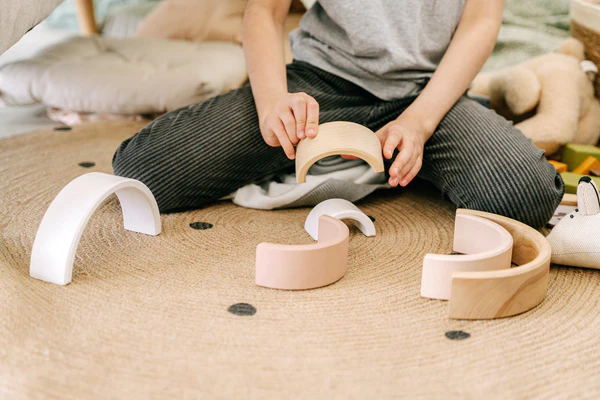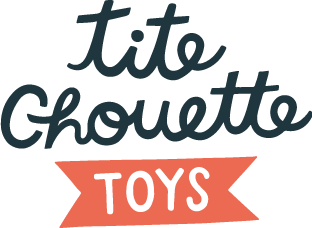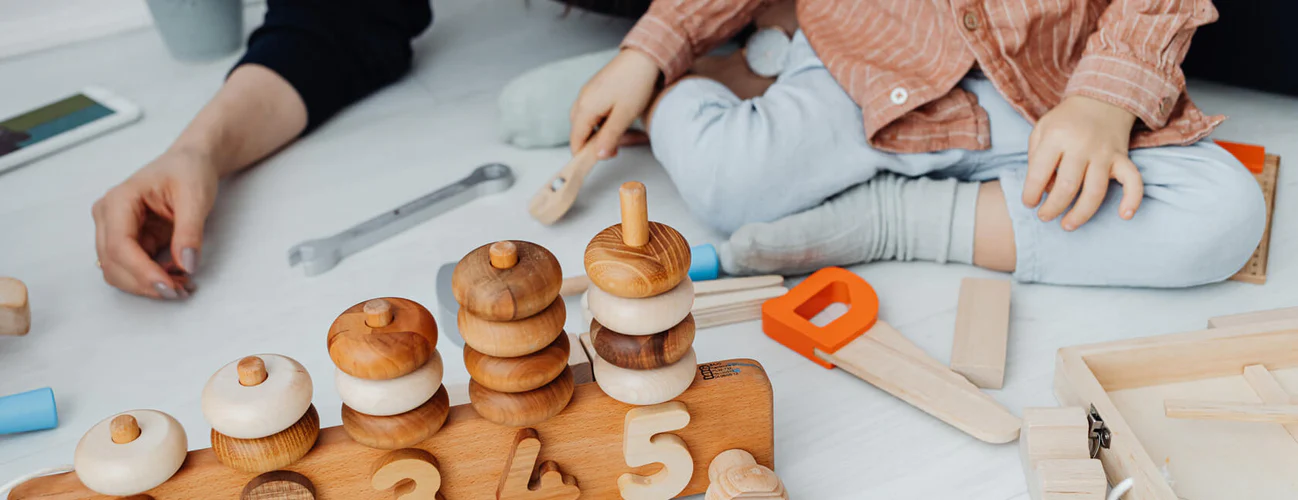Maintaining and extending the life of wooden toys is essential to preserve their natural beauty and guarantee their longevity. Wooden toys have always been appreciated for their warmth, sturdiness and educational qualities. To keep these precious objects in optimum condition, it’s important to adopt good maintenance practices.
- Best cleaning practices for wooden toys
- Regular cleaning
- Use the right products
- Careful drying
- Moisture protection
- Wood treatment
- Choosing the right care products for wooden toys
- Avoid abrasive products
- Use a protective coating after cleaning
- Follow manufacturer’s instructions
- Preventing wear and tear: tips for protecting wooden toys
- Repairing and restoring: how to refurbish a damaged wooden toy
Nous verrons dans cet article
We’ll give you helpful tips on how to care for your favorite wooden toys so they can be passed down through the generations with pride.
You’ll also discover how to extend their lifespan with a few simple but effective tips that will save you time and money while protecting your investment in these timeless children’s treasures.
Best cleaning practices for wooden toys
Wooden toys are prized for their sturdiness, aesthetics and eco-friendliness. To maximize the lifespan of these precious objects, it’s essential to adopt the best cleaning practices. Here are a few tips to help you maintain and preserve your wooden toys.
Regular cleaning
Regular maintenance helps prevent dirt build-up and wood deterioration. Remember to dust wooden toys with a dry or slightly damp cloth at least once a week.
Use the right products
To preserve the quality of wood, avoid aggressive chemical products that can damage the material. Instead, use mild cleaners such as black soap or white vinegar diluted in lukewarm water. Apply this solution to a clean cloth before gently rubbing the toy surfaces.
Careful drying
Once you’ve cleaned your wooden toys, make sure they’re completely dry before putting them away or giving them back to the kids to play with. Let them dry naturally in the open air, away from direct sources of heat, to avoid any risk of damage to the material.
Moisture protection
Prolonged contact with water can cause wood to swell and warp, and encourage the growth of mould. So avoid leaving your toys in a damp environment for too long, and store them in a dry place.
Wood treatment
To extend the life of wooden toys, you can apply a thin layer of linseed oil or beeswax to the surfaces. This treatment will nourish the wood, giving it a smoother, shinier appearance and enhancing its resistance to stains and scratches.
By following these tips, you’ll preserve the natural beauty of your wooden toys, so that children can enjoy their favorite toys for a long time to come.
Choosing the right care products for wooden toys
The lifespan of wooden toys is an essential aspect to consider when offering quality toys to your children. To preserve this longevity, it’s essential to choose care products adapted to wooden toys. Here are a few tips to guide you in your choice.

Take product composition into account
Cleaning products for wooden toys must be environmentally friendly and safe for children. Choose natural cleaners such as black soap or white vinegar, which are gentle on wood and pose no health risk.
Avoid abrasive products
Detergents and other harsh chemicals can damage the surface of wood and shorten its lifespan. Instead, use a soft sponge or damp cloth with a mild cleaning product to remove stains and dirt without scratching or damaging the material.
Use a protective coating after cleaning
After cleaning your wooden toys, remember to apply a protective coating to preserve their appearance and durability. Natural oils such as olive oil or linseed oil are ideal, as they nourish the wood while forming a barrier against water, dust and scratches.
Follow manufacturer’s instructions
It is essential to scrupulously follow the manufacturer’s recommendations for the care of wooden toys. Some toys may require special treatment or attention during cleaning, and failure to follow these instructions can lead to premature deterioration.
In short, to ensure the long life of wooden toys, it’s vital to choose the right care products that respect the material. By following this advice and the manufacturer’s instructions, you’ll help preserve the quality and aesthetics of your wooden toys, to the delight of your children.
Preventing wear and tear: tips for protecting wooden toys
The lifespan of wooden toys is an important aspect to take into account when choosing to give this type of toy to a child. Wooden toys are renowned for their sturdiness and longevity, but there are a few tips to protect them and prevent premature wear.
Use a protective varnish
Using a protective varnish on wooden toys can considerably extend their lifespan. This product forms a barrier that protects the wood from moisture, dirt and scratches. It is advisable to use a non-toxic, environmentally-friendly varnish to avoid any risk to children’s health.
Regular cleaning
Regular maintenance also improves the durability of wooden toys. We recommend cleaning with a damp cloth soaked in warm, soapy water (use a soft sponge if necessary). Avoid excessive use of water, however, to prevent the wood from warping or cracking.
Avoid direct sunlight
The sun can cause damage to wooden toys over time, such as bleaching or discoloration of the material, as well as drying out, which can lead to cracking or warping of the wood. To avoid this, we recommend storing these items in a cool, dry place away from direct sunlight.
Avoid shocks
Repeated shocks can damage wooden toys and shorten their lifespan. It is therefore important to teach children to handle these objects with care, and not to throw them or knock them against hard surfaces.
Proper storage
Proper storage also extends the life of wooden toys. Make sure they’re stored in a dry, well-ventilated place, and that they’re not piled too high to prevent the weight from damaging the toys underneath.
By following these simple tips, you’ll not only help preserve the life of your wooden toys, but also provide children with a healthy, sustainable play environment.
Repairing and restoring: how to refurbish a damaged wooden toy
The lifespan of wooden toys is an essential consideration for parents concerned about the environment and sustainable development. Indeed, these playthings are renowned for their sturdiness and longevity, making them particularly suitable for children who tend to be careless with their playthings. Sometimes, however, these crafts are damaged or deteriorated by time and intensive use.
To give a second life to these precious wooden toys and extend their useful life, several repair and restoration techniques can be employed. In this section, we’ll take you step-by-step through the various stages involved in restoring a damaged wooden toy to its former glory.
Step 1: Damage assessment
First of all, it’s important to examine the toy thoroughly to assess the extent of the damage. This may include superficial scratches or scuffs, as well as deeper cracks in the wood structure.
Step 2: Cleaning
Before any work is carried out on the raw material, a thorough cleaning must be carried out to remove the dirt and dust that has accumulated over time. Use a soft brush soaked in soapy water, then rinse with a damp cloth, without wetting the wood too much to avoid swelling.
Once the toy is clean, it’s time to start sanding to remove surface roughness and imperfections. Use a fine-grain sandpaper (120 or 180) and sand gently in the direction of the wood grain until you obtain a smooth surface.
Step 4: Filling cracks
If your toy has cracks, you can use wood filler to fill them. Apply it generously into the crack, then smooth with a spatula before allowing to dry according to the manufacturer’s instructions. Once dry, lightly sand the treated area to even it out.
Step 5: Finishing
To protect the restored toy and restore its original appearance, you have several options: apply a coat of natural oil (such as linseed oil), use an eco-friendly varnish or repaint with a child-friendly acrylic paint. Allow to dry according to the instructions on the chosen product.
By following these simple steps, you’ll be able to restore your damaged wooden toys and extend their lifespan. You’ll not only be helping to preserve our planet, you’ll also be helping to keep your little ones happy, with their favorite toys looking as good as new again!

